Dreamy Blue Painted Dresser
Have you been searching for the perfect way to give your bedroom furniture a beautiful transformation? Look no further than this DIY blue dresser makeover! With just a few simple steps, you can transform a basic painted dresser into an eye-catching navy blue chalk paint dresser that is sure to be the envy of your friends. We’ll provide you with all the tips and tricks to get this unique blue painted dresser look.
Get more blue painted furniture ideas here!

Can you believe that we picked this dresser up for free from Facebook Marketplace? It was in rough condition when we picked it up, but these are my favorite makeovers!
Turn your old dresser into something you will love with this step-by-step tutorial on how to chalk paint furniture! Let’s dive in!
Supplies Used for Blue Painted Dresser
As an Amazon Associate, I earn from qualifying purchases. I also may earn from other qualifying purchases with other companies or get free product to review and use. All opinions are my own.
- Vintage Empire Dresser
- Sandpaper to prep for paint
- Clear Shellac to prep for paint
- Paint Sprayer or Paint Brush
- Country Chic Paint in Peacoat
- Country Chic Paint in Jitterbug
- My Favorite Polyurethane
- Country Chic Paint Graphite Glaze
- Cheap Paint Brush for glaze
- Vinyl Gloves for glaze
- Baby Wipes for glaze
Grab my list of 10 must have painting furniture supplies here.
How Much Paint Do You Need?
You can paint a dresser about this size with less than one pint of paint. I don’t think that the sample sizes would be enough, even when you use both colors.
You shouldn’t need any more than a sample size of the glaze though! (Glaze goes very far!) One can of shellac should be enough as well.
Repairing Damaged Veneer
This dresser needed a lot of extra attention before I could start painting! Look at that top left drawer!

The veneer had to be removed on the top drawers. And then filled in, in other areas. Want to repair without painting furniture? Learn how to repair chipped veneer furniture here.
We also love this technique for wood stain repairs where you don’t need to restain the whole surface after you fix the damage.
Get the Secrets!
Grab this super convenient How to Repair Furniture Ebook with all of our secrets on how to repair furniture for only $14.
You can print it out and have instant access whenever you come across damaged furniture, and know exactly how to fix it!
Click on the picture of the book to purchase!
If you have to remove the veneer, learn how to remove veneer here. If your furniture has chipped veneer that needs filled in, this is the best way to fix chipped veneer!

Prepping Dresser for Blue Paint
I know this is the step that always gets skipped over. But it’s honestly super important, even if you use chalk paint!
Even though most chalk paint says that it will adhere to anything. Trust me, and don’t believe it.
Spend ten to fifteen minutes on a little bit of prep work so your newly painted furniture can last a long time! Read more about how to prepare furniture for painting here!
First, clean your furniture with a grease / oil cutting cleaner. I like to use Krud Kutter. Check out other options for cleaning furniture before painting here!
If your furniture has any slickness or shine to it, it MUST be scuff sanded (this should only take a few minutes) so then your paint has something to hold onto.
Otherwise, the paint can easily scratch off, or even peel off!
Simply scuff sand with 220 grit sandpaper (this sandpaper is the BEST kind!). Find other great sandpaper for furniture painting here.
Rub it all over the dresser, making sure that it removes all of the shine. Check out this post to learn more about the importance of sanding before painting furniture.
If you don’t want to scuff sand by hand, here are the best sanders for furniture.
Then remove the dust with a vacuum hose attachment and/or a damp lint-free rag. For the best dust removal, I like to use these tack cloths! They pick up all the dust and don’t leave any lint behind!
I know chalk paint says that you don’t need to prime. But, they don’t tell you about bleed-through issues you will most likely have if you don’t.
Bleed through is a nasty bugger that shows up as little stains in your paint. No matter how many coats of paint you put on, they will just keep showing up.
And when you seal your chalk paint, they get even worse! (Just when you think you’re done with your project!)
I always give my furniture two coats of clear shellac to combat that mess. Check out the best primers for painting furniture (and how to choose the right one) here.
*Bonus! Shellac will help your chalk paint adhere even better!!
*Bonus 2.0! Since it’s clear, you can distress your painted furniture and not see ugly white primer underneath!
Spraying clear shellac is also one of the tricks on how to get rid of smoke smell in furniture and other unpleasant odors, especially if you got your piece from a thrift store.
Learn more about how to get rid of bleed-through and how to stop stains from coming through paint here!
If you’re painting laminate furniture, you need to use a specific primer to really ensure that your paint will stick. Check out how to paint laminate furniture here.
Painting Dresser Navy Blue
Okay, finally, we can move on to the paint! I mixed two colors to get this stunning blue chalk paint! Mix 2 parts Jitterbug chalk paint to 1 part Peacoat chalk paint.
Check out this makeover on painting furniture navy blue, using Peacoat without mixing it with Jitterbug. Check out more dark blue painted furniture ideas here.
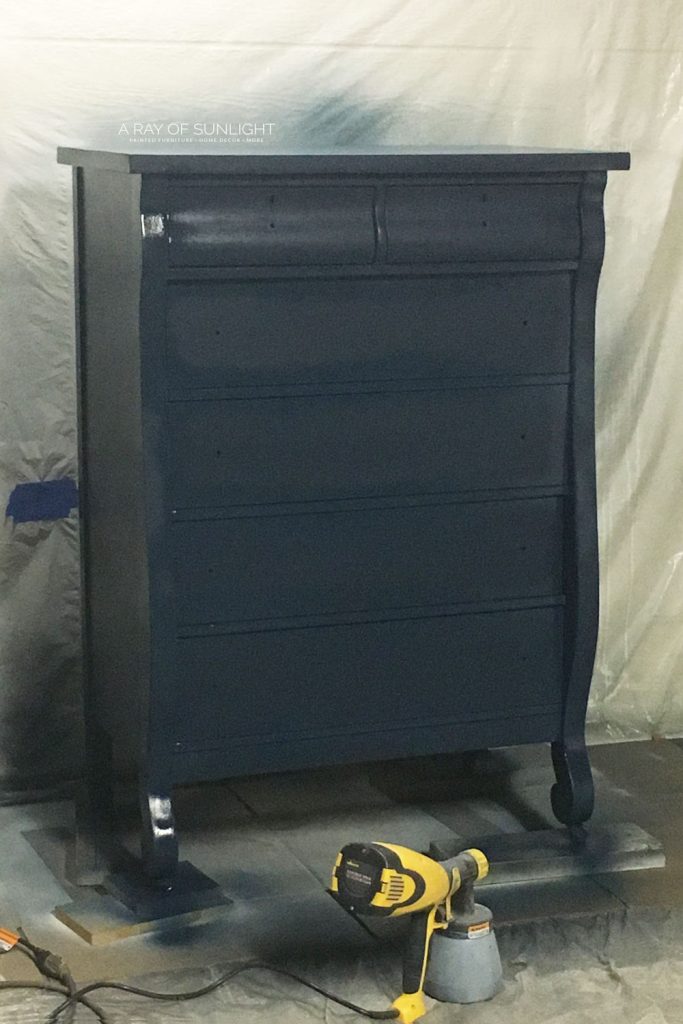
I used my cheap little Wagner Double Duty paint sprayer to paint on 2 coats, but you can use a paintbrush! Learn how to spray paint a dresser with chalk paint here!
If I have to use a paintbrush, I choose from this list of the best paint brushes for painting furniture. Read about how to paint furniture without brush marks here.
One amazing thing about chalk paint is how fast it dries! Make sure to let your paint dry between coats. This is what it looked like after the paint was dry. (And a couple of coats of poly!)
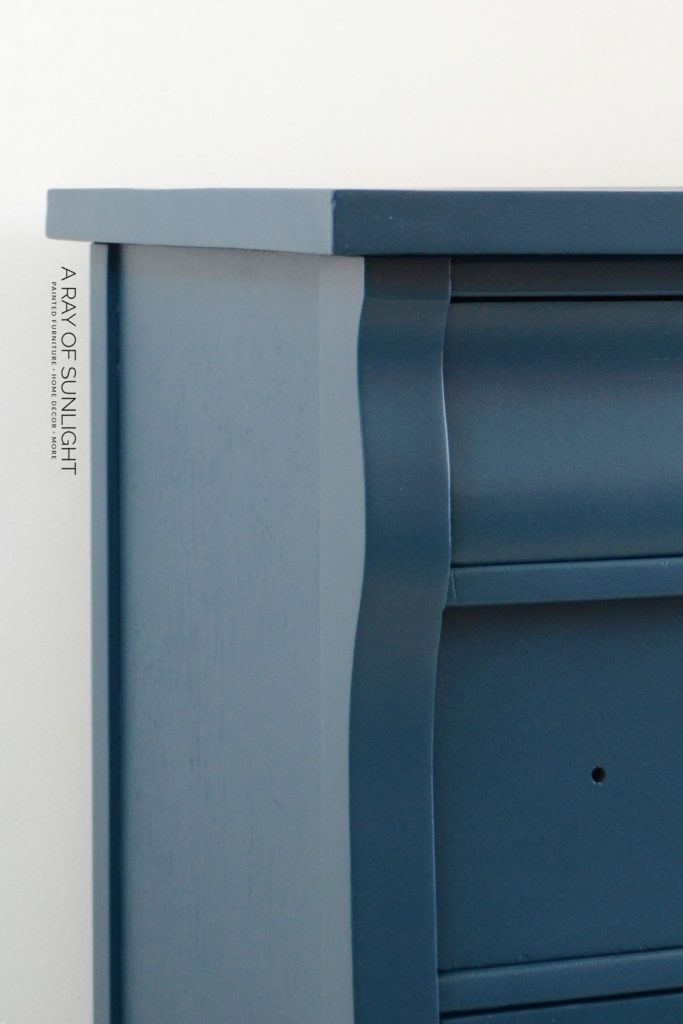
There’s something missing huh? Yep! I put a black glaze over the chalk paint!
Glazing Over Chalk Painted Dresser
Now onto the big question, how to glaze over chalk paint?
Need to SEE how to glaze? Check out this video on how I glaze over chalk paint.
Chalk paint is very porous, so the second you put a glaze right on top of the chalk paint, the glaze will soak right in. Trust me, it’s not pretty!
You need to be able to move the glaze around to create this look!
The trick to glazing over chalk paint is to seal the chalk paint with poly before glazing. Water-based polyurethane creates a surface that is perfect for glaze!
Seal Chalk Painted Dresser
The first step is to seal the chalk paint with one to two coats of water-based poly (the best stuff!)
You need to make sure you completely cover the chalk paint so the glaze doesn’t soak into the chalk paint. Then you need to let the polyurethane dry for at least 24 hours.
Otherwise, all the moisture from the glaze and wiping it around will lift up the chalk paint and make it very easy to scratch off. Learn all about different topcoats for painted furniture here!
How to Glaze Painted Furniture
I like to apply two coats of glaze.
- First, the base coat. Basically, I like to get a nice even layer all over.
- After the first coat is completely dry, I add extra glaze in the corners to create some shadowing.
I also like mixing a little water into my glaze so it doesn’t dry as fast. (I don’t measure how much water, but it’s not much.)
Simply brush the glaze all over with a cheap paint brush. Make sure to really get it in any details, corners, and crevices. Work in small sections (like one drawer, or side of the dresser).
I like to brush it on thicker so it doesn’t dry as fast. I also don’t let the glaze sit for more than 20-30 seconds.
Use baby wipes to wipe off the glaze. Wipe in long passes that go the same direction as the wood grain did. And try to make it not look streaky. Learn more about how to glaze over chalk paint here.
Remember, you can easily add more glaze, but you can’t remove it once it’s dry. (You’ll need to paint over it, and basically start over.)
Every single time I start glazing a piece of furniture, it takes me a little bit to get back into the groove of it. But it gets easier as you go!
When you’re happy with the base layer, let it dry completely! (Brushing on more glaze while the first coat of glaze is wet will lift up the first coat of glaze.)
For the second coat, I find myself “dry brushing” the glaze on. I get a teeny tiny amount of glaze onto the tip of my brush, then I dab it onto a paper towel to get rid of excess paint.
Then I lightly brush the glaze on in the corners and feather it out a bit.

If I put too much on, I quickly wipe it off and try again. If I don’t put enough on, I get a little bit more glaze and dry brush a little bit more in that area.
When you’re happy with it, let it dry completely. Check out my comparison between glaze vs wax over chalk paint to learn more.
Seal the Glaze
After the glaze, I spray three more coats of my favorite water-based poly. Learn ALL of my tips and tricks on how to spray polyurethane here!
The poly helps protect the paint and glaze from getting scratched and helps give it a sheen (so you can easily wipe down the dresser). You can brush the poly on if you don’t have a sprayer!
I hope that all makes sense! If you have any questions, please leave them in the comments below!
More Glazed Furniture Makeovers
Want more ideas for glazed furniture? Here are more of our furniture makeovers that have glaze on them! You’re sure to find something that gives you the inspiration you’re looking for.
- Grey Painted Dressers
- DIY Emerald Green Dresser
- Teal Blue Tall Dresser
- How to Create a Weathered Wood Gray Finish
- How to Turn a Dresser to TV Stand
- French Provincial Nightstands Makeover
- Antiqued Blue Farmhouse Buffet
- Painting Furniture Gold
Now, here’s the after of this dreamy blue dresser makeover in its fully glory. What do you think??
Here are more bedroom dresser ideas to show off your personal style!
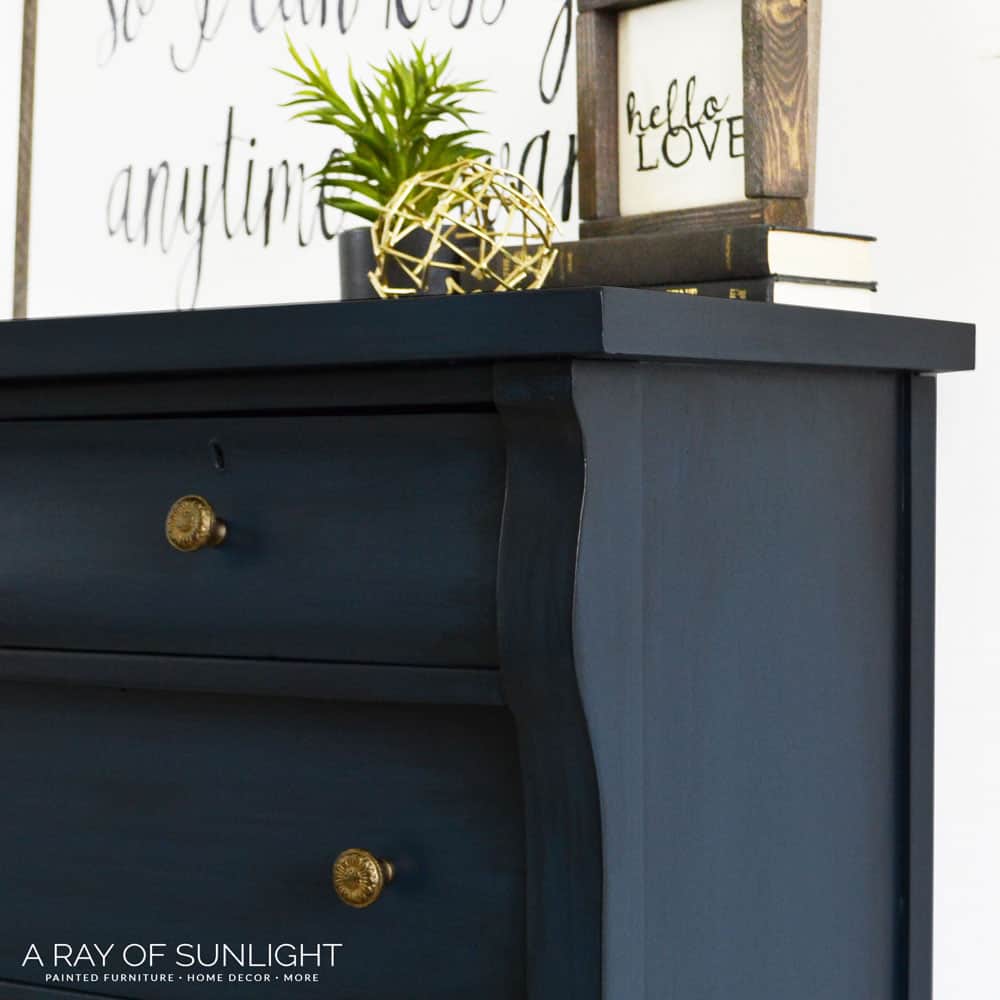

More Before And After Makeovers
Click any of these “before” photos below to view the “after” of that makeover.

Dreamy Blue Painted Dresser
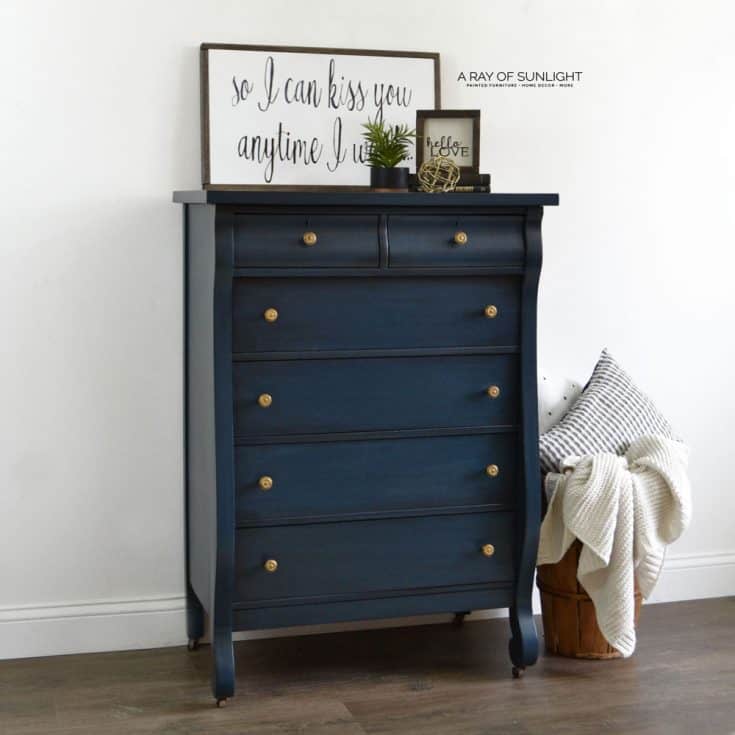
Give life to your old dresser with chalk paint and some glaze. Here are the steps for this dreamy blue painted dresser.
Materials
Instructions
- Check your dresser for any damaged and chipped veneers and repair them. Remove any hardware, clean the dresser with Krud Kutter, and if your furniture has any slickness or shine to it, scuff scand it so your paint has something to hold onto. Remove all the dust with a vacuum and tack cloth.
- To avoid bleed through issues, prime the dresser with 2 coats of clear shellac.
- Get your blue chalk paint of choice and apply 2 coats. Make sure to let your paint dry between coats.
- Now, seal the chalk painted dresser with 1-2 coats of water based polyurethane. Make sure to completely cover the chalk paint so the glaze you're going to apply next doesn’t soak into the chalk paint. Let the polyurethane dry for at least 24 hours.
- Apply a base coat of glaze all over the dresser. After the first coat is completely dry, add extra glaze in the corners to create some shadowing. Don’t let the glaze sit for more than 20-30 seconds and use baby wipes to wipe off the glaze.
- Let the glaze dry completely before sealing it with 3 more coats of water based poly.
- Add hardware back to the dresser.
Recommended Products
As an Amazon Associate and member of other affiliate programs, I earn from qualifying purchases.
More Blue Furniture Makeovers
- Blue Chalk Paint Coffee Table
- Turning a Dresser into a TV Stand
- Antique Desk Makeover
- Corner Cabinet Makeover
- DIY Painted Hallway Cabinet
Follow us on YouTube to get more tips for painting furniture.
Or share your project with us on our Facebook Group and be part of our community. See you there!


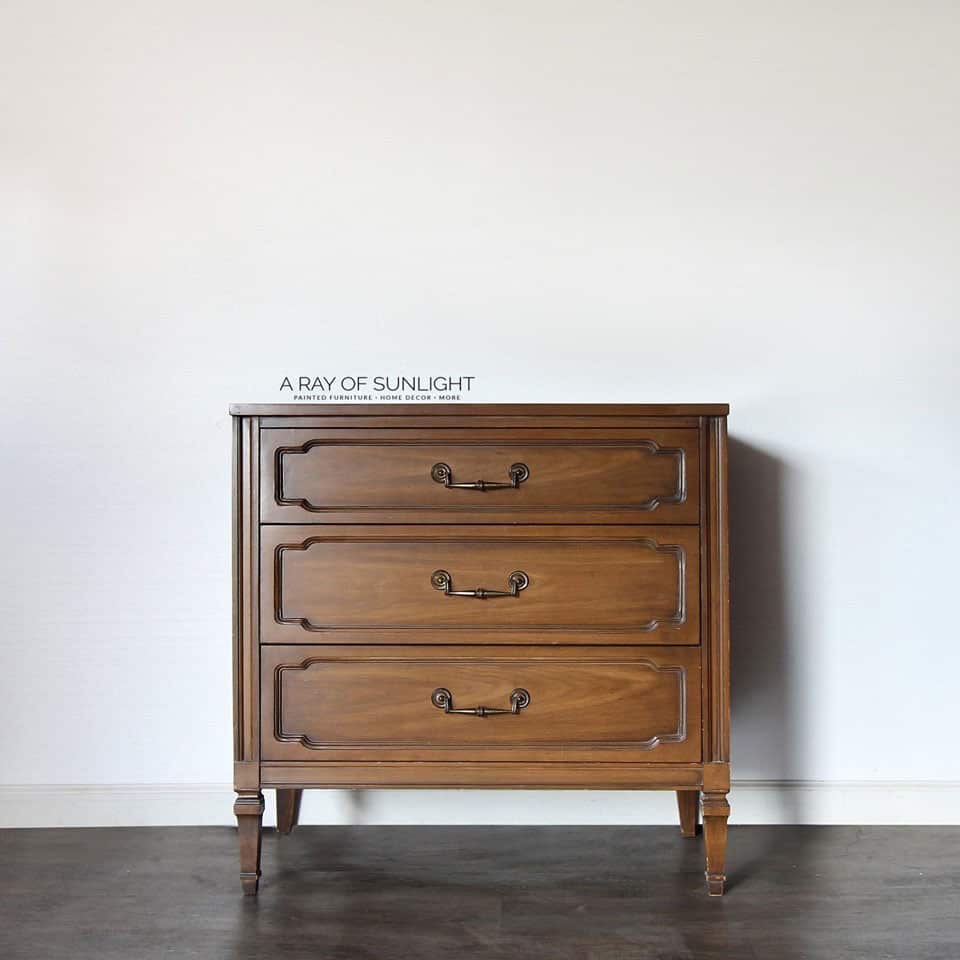






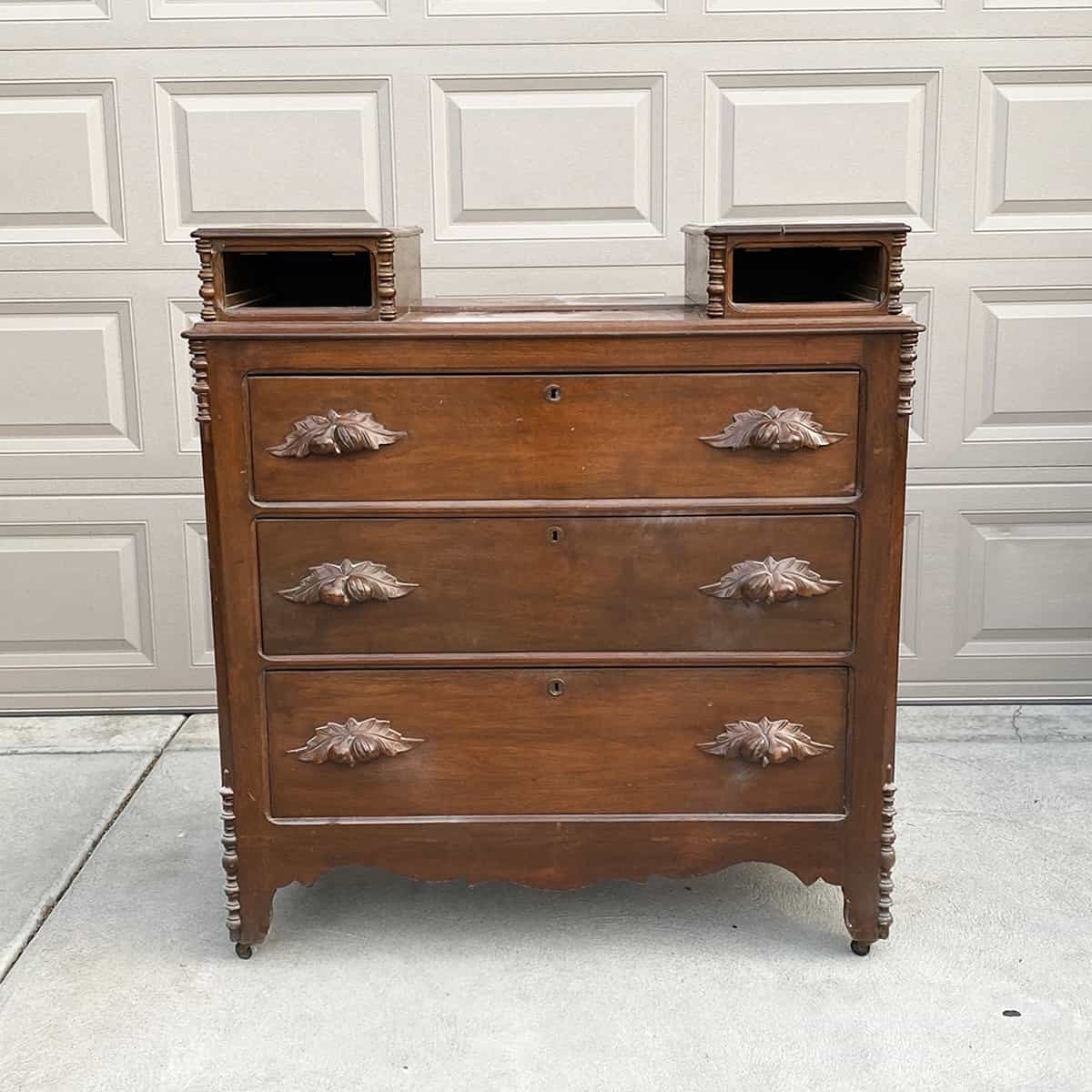
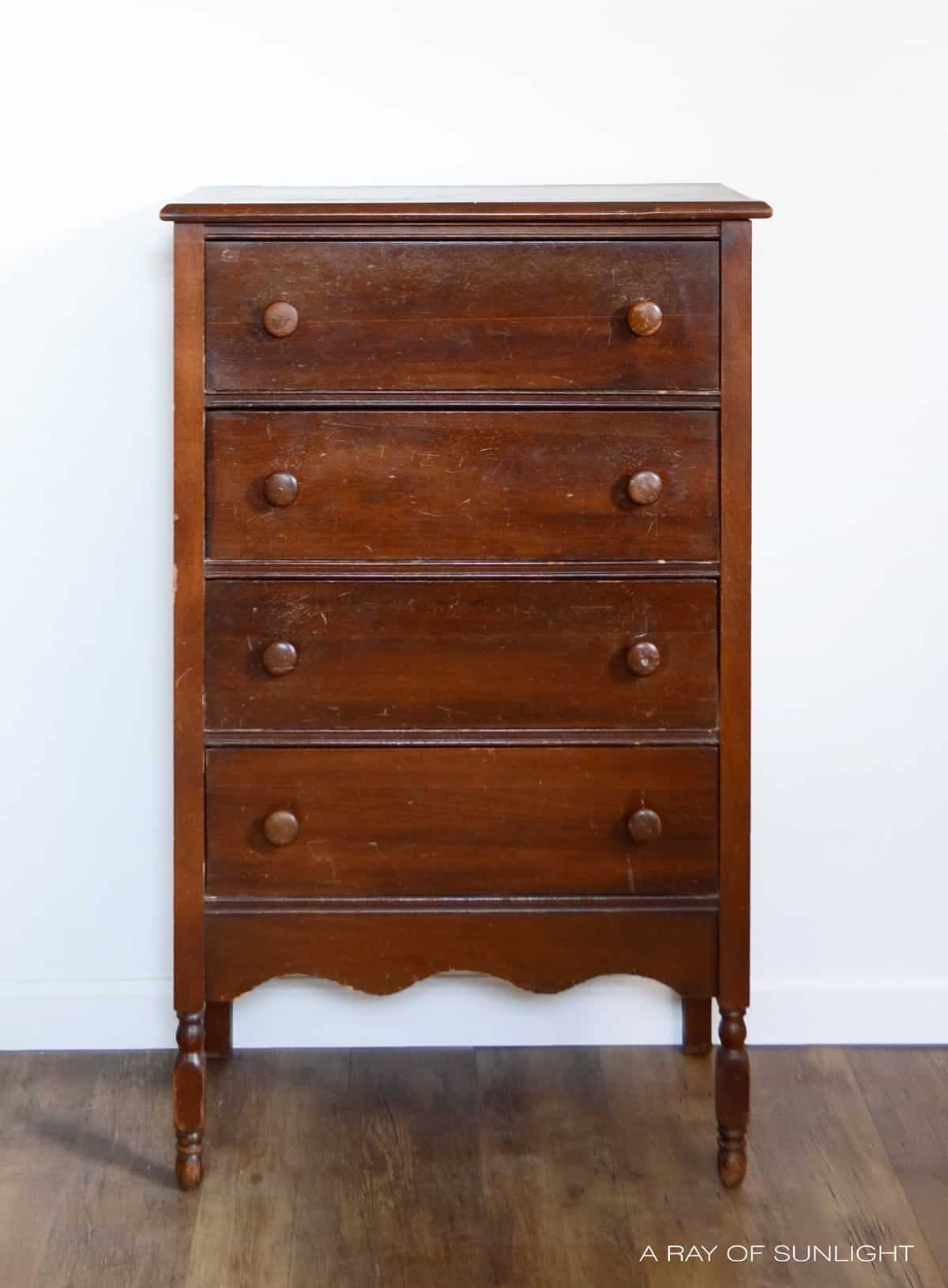
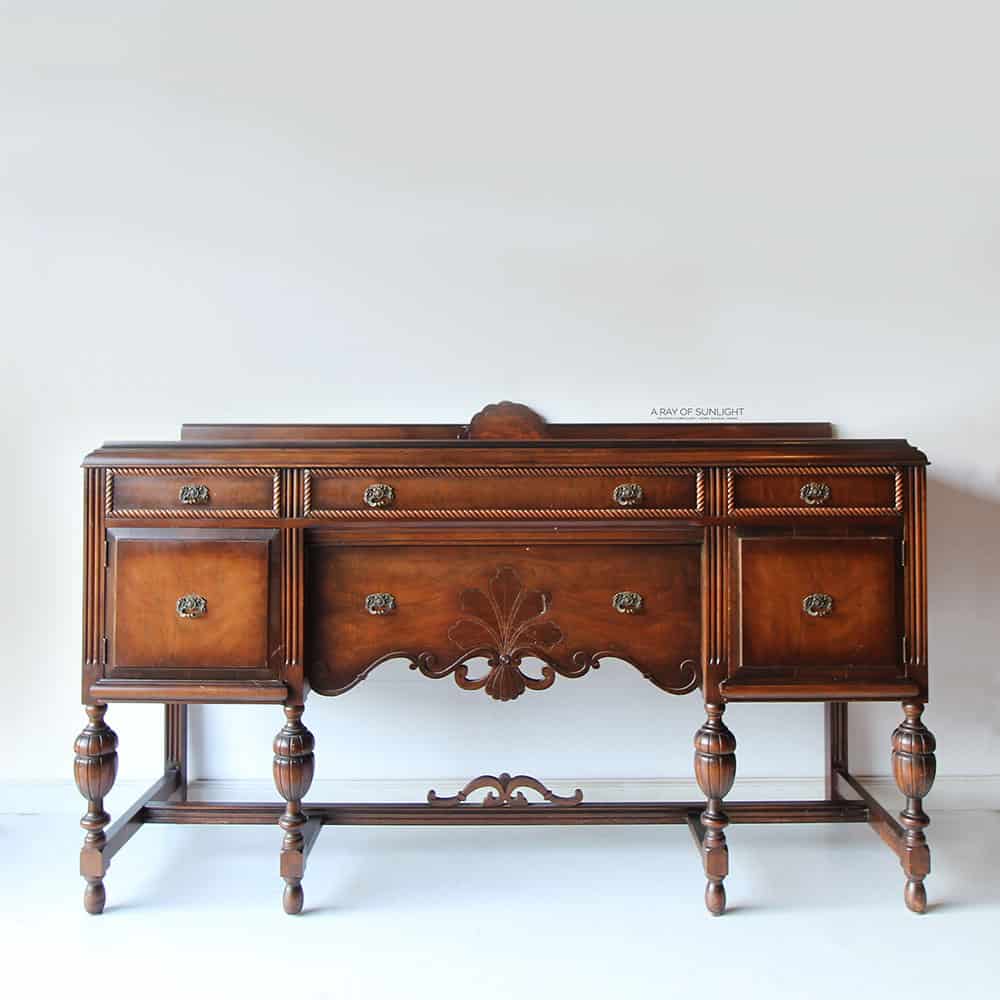

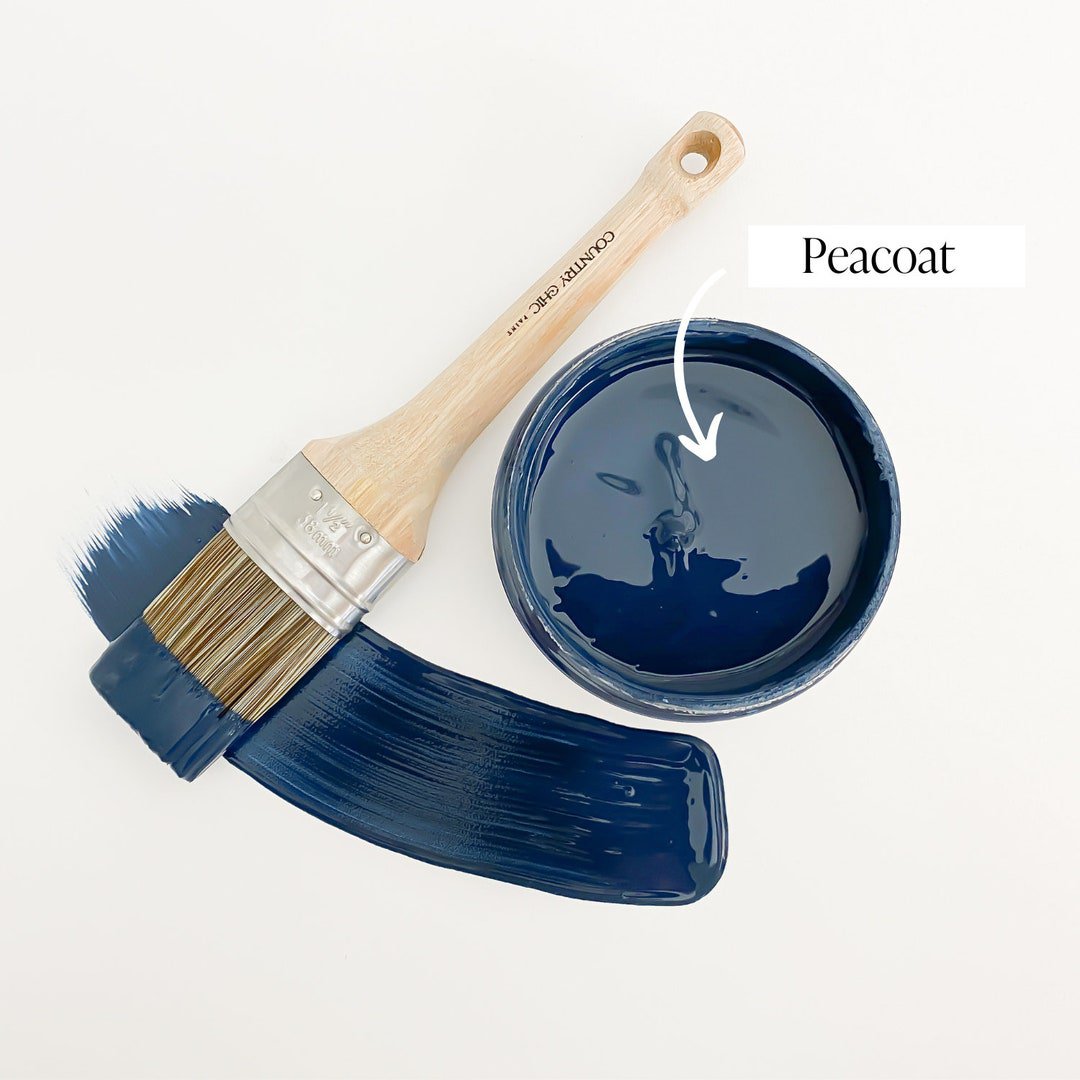
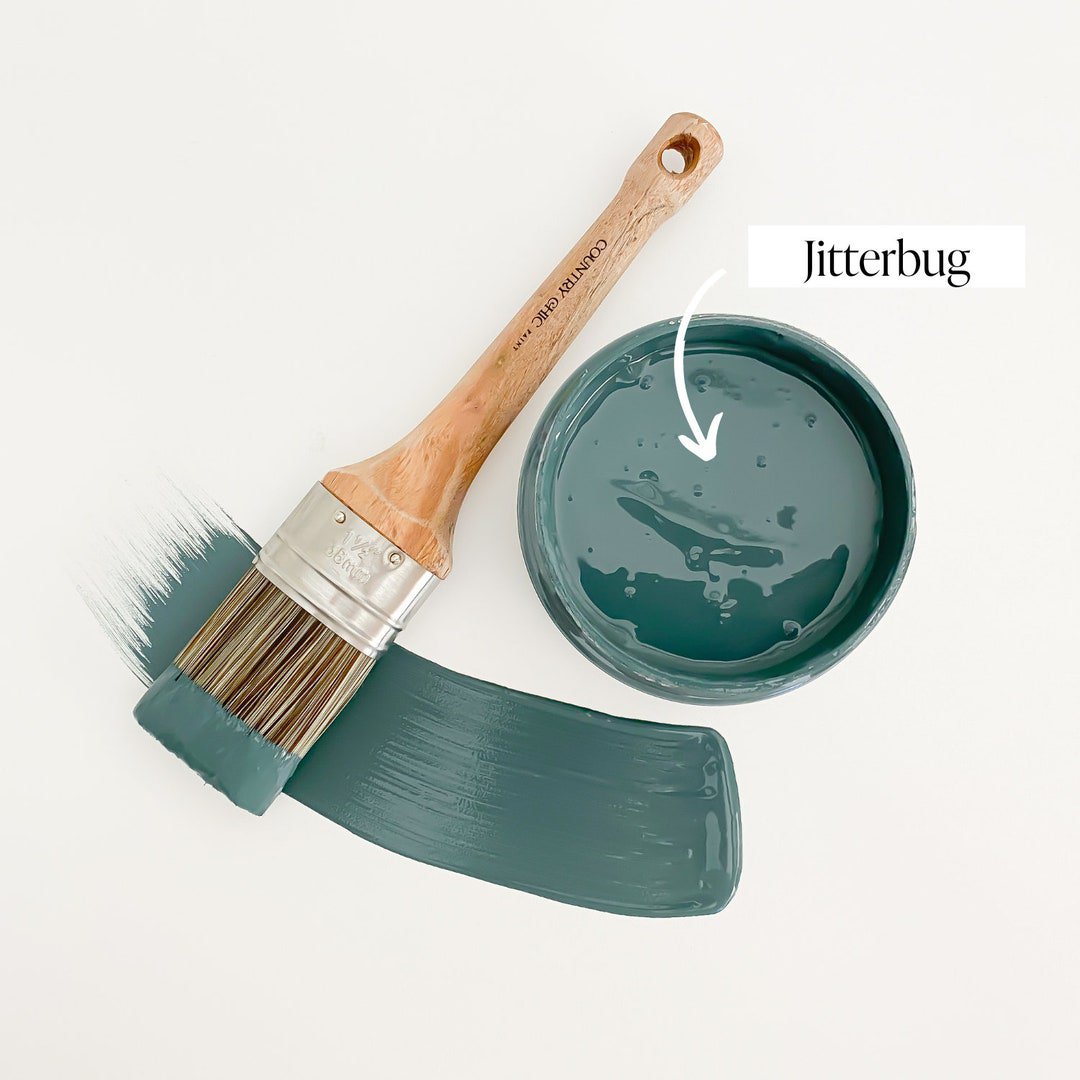


Do you use the same sprayer for paint and poly? I’ve never used a sprayer, first time DIY furniture.
Love your blog and instagram.
Thx!
Hey Lauren!
Yep, I use the same sprayer for paint and poly. I just clean it out before I change products and if I won’t be using it again in the next couple of hours.
The paint usually has to be thinned out a bit more than the poly, but both paint and poly spray great from the same paint sprayer.
Best of luck!
Thank you for the information very informative. I’m a newbie and was told milk paint was easier to work with. Would I follow your same instructions with milk paint? And can you use poly from a spay can? Thanks Lori
Hey Lori!
There are a couple of different kinds of milk paint. One comes in a liquid form like most paint and the other comes in a powdered form that has to be mixed with water. Powdered milk paint is definitely the easiest to use if you have old WOOD furniture. I have quite a few posts on how to paint with milk paint (just search milk paint on here and you’ll find a bunch!). Milk paint is different than chalk paint, so I wouldn’t follow the same instructions necessarily.
As for the poly in a spray can. Yep! You can spray it from a spray can. It works great!
Best of luck! Natalie
Hey Natalie! Are you able to post a demo video putting the black glaze on? I am currently working on my very first piece. An old night stand someone put with their trash at the curb. Learning a lot from you blogs so thank you for those.
I have a piece of black Ikea furniture that my daughter now wants white. Have you ever redone Ikea furniture? It’s a black Hemnes dresser. It says its made mostly from solid wood, but to me it has a weird texture and finish. Kind of nervous to redo it but figured I might as well try if it will save me 250.00.
Thank you,
Jennifer
Hey!
Thank you for your kind words!
I have a video, but I haven’t had time to edit it and post it. #needmoretime haha
Ikea furniture can be treated the same as this post on how to paint a laminate dresser. The most important things are the scuff sand really well and to prime it with a primer that will stick! Learn more about primers with this post about the best primers for laminate
Best of luck on your painting adventures!
I am an avid chalk painter but I learned so much more by just reading this post. Thank you and glazing here I come.
Thank you so so much for the love Anita! I’m so excited for you! Best of luck!
So, out of curiosity, how long did this piece take to finish? That’s a lot of coats with drying times.
Hey Angela!
I’m not going to lie, this dresser took me about a week or so. It’s not a quick project by any means. But the final result was totally worth it!
Hello! I love this dresser – just beautiful! I’ve heard that chalk paint is difficult because you have to wax it every year. Is that true even if you put the poly over it? Also, have you had time to edit the video on using the black glaze? I want to attempt it, but I’m nervous!
Thanks so much!!!
You can either put wax on chalk paint or you can put poly on chalk paint. If you put wax on chalk paint, you can’t put poly over the wax as the wax will repel anything you put on it until it is completely cured. Poly doesn’t need to be applied every year.
I had to redo the glazing video, but it’s the next video I’m working on for sure! Thanks for your patience!!
Absolutely beautiful!! Where did you get the knobs? My favorite ?
I believe they are black knobs from hobby lobby and then I painted them gold.
What type of glaze did you apply on this blue and where can I get it?
Hey there! All of that info is up in the post. Best of luck!
Just wondering if you sand after each layer of poly?
For the softest, smoothest finish, yes I sand between each coat of poly.
I love the dresser, I used to have it. It now resides in a family friend s home for their daughter. However, I have similar pieces I want to freshen up. Your tips are invaluable.
Thanks again ?
What a great piece of furniture! You did an excellent job, I’m thrilled for you! I Love restoring old pieces of furniture, you are inspiring, thank you
Hi! I recently found an Empire dresser that looks just like this only a darker mahogany color. I was wondering if you found any information about a date on it. Ours was stamped with Holland Furniture Company and we estimate earlier than 1920. We are planing to remove the (at least) century of grime and remove the finish to see the original wood. We may seal the color or refinish with a new stain.
Hey!
I’m definitely not great with dates that pieces were made. I’m excited for your makeover! It will be gorgeous refinished!
I have one. It was my grand-aunt Rose’s christening gift to my mom, her god daughter, in 1921. It was new when given to my mom. After having it appraised, we decided not to do anything with it, except clean it up. It was an arduous task, but keeping the value (and family story) was worth the effort.
You are my inspiration! I’m trying my first piece but am
Hand painting. I bought a sprayer ( probably way too cheap ) and it was broken so I returned it. I want to see how well this turns out and if it’s good , I may invest in a good one.
I’m retiring at the end of the month so I’m hoping I have time to do more of these. It’s lovely to see the final products. You do great work and with such ease and very little mess. I’m a complete slob !??
Thanks for the great videos and “ how to’s”.
I have recently stumped across your videos. I find I really don’t need to watch any other tutorials now cause you explain each step very clearly. I enjoy them immensely. Instead of the spray shellac could I use the liquid instead? I know the spray would be convenient but I’m nervous I’ll miss spots when doing this process. Am I being overlying concerned? Thank you
Thank you! Yep you can brush on the stuff in a regular can instead of the spray can version.
I love this color and have an antique bedroom set that I’m going to try to replicate. I confused about the ratios of the chalk paint. In your video it says 1/4 pea coat and 3/4 jitterbug. In reading your directions it says 1/3 pea coat and2/3 jitterbug. I’m sure it probably doesn’t matter with the ratios but knowing me, I’ll have a panic attack before I’m spraying shellac.
Thank you so much for your inspiration!
Mary
The video and post were a little bit different (different pieces and I had a different amount of paint on hand when I did the makeovers). So if you want the color of the piece in the blog post, you’ll follow what it says in the post. If you want the color that is in the video, you’d follow that ratio in the video.
Either way they are pretty close.
Best of luck!
Can I use polycrylic instead of polyurethane? I’ve used it several times and like the finish. It also doesn’t have the harsh smell as polyurethane. If so, should I thin it? Thank you for the step by step instructions! Looking forward to redoing an armoire with the beautiful blue paint and gold hardware!
Yep! Polycrylic is basically the same stuff I use. But the brand I prefer is Varathane and they call it polyurethane, even though it’s waterbased (unlike the oil based stuff that is usually called polyurethane.)
So yes, you can, and yes I would still thin it out. It’s basically the same thing. Best of luck!
Thank you! I have another question! Did you sand in between shellac applications?
Nope I don’t.